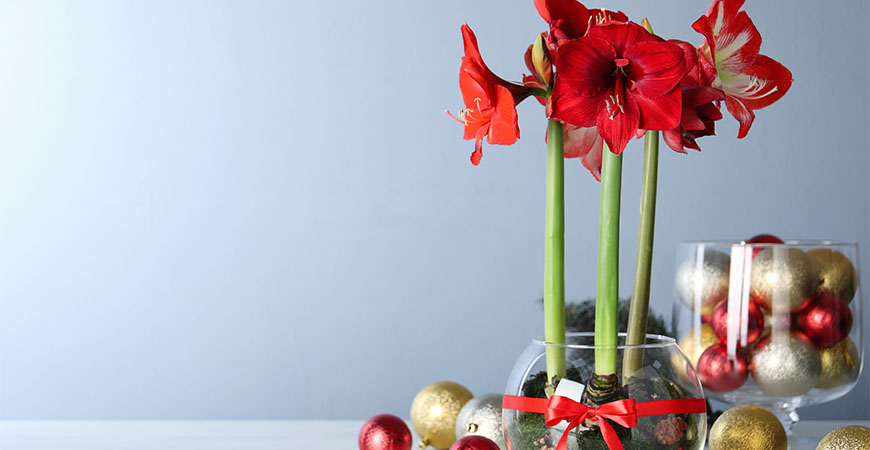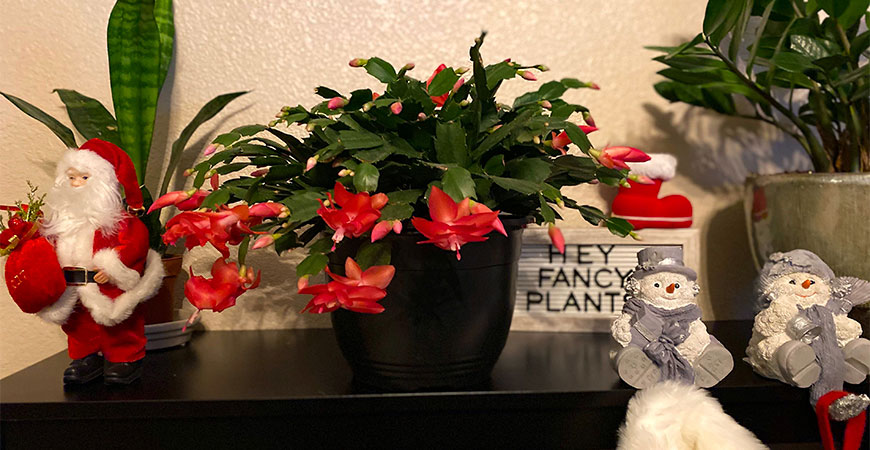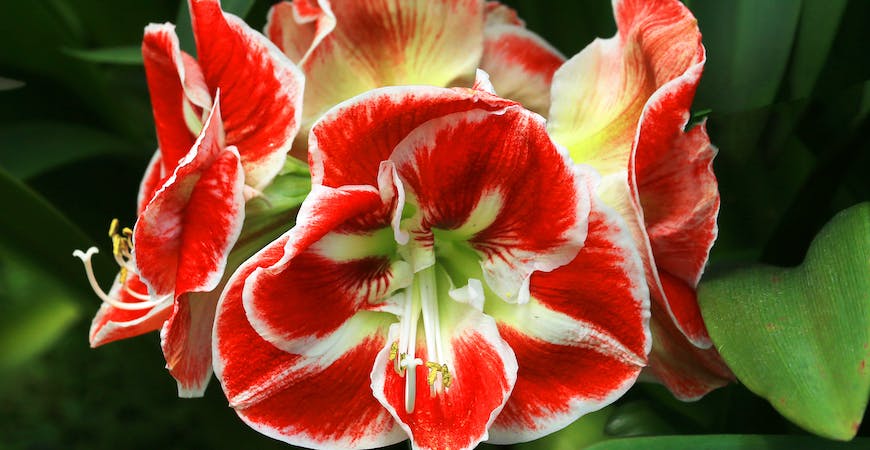
Holiday Planter Ideas for Traditions New and Old
The winter holidays are an especially floral one. Arbor Day aside, it’s hard to find a holiday more tree-forward than Christmas.
So, as you start to consider Christmas planter ideas, Hanukkah centerpieces, or inviting flower arrangements, consider checking this list twice. The list of our favorite plants to decorate your home with for the holidays that is.
On it, you’ll find options for traditions, new and old. With this already being the most wonderful time of the year, it only takes the right flowers to transform the season into something even more special.
Amaryllis
While many holiday hosts already employ the vibrant amaryllis flower as temperatures drop, we think there are plenty more people who should be aware of this plant with its trumpet-shaped flowers. Though they are a common substitute for the classic poinsettias, they shouldn’t be considered anyone’s second choice for a red Christmas plant.
Amaryllis flowers come with two built-in holiday features. First, their varieties come in colors that match the season: red, pink, and white.
Second, if you plant their bulbs near Thanksgiving, you’ll see their beautiful blooms just in time for Christmas. As your holiday spirit grows, so does the amaryllis bulb.
When planting, choose a pot that’s at least six to eight inches wide, preferably one made of ceramic clay. Their blooms tend to be top-heavy, so a lightweight pot is a recipe for an epic tumble.
To prevent root rot or overwatering, use a pot with drainage holes. That means you’ll also need a drip tray to prevent holiday disasters.
When planting, first place a couple of inches of soil in the pot. Then, add a slightly damp potting mix and place the amaryllis bulb into the mix with the pointed end pointing up.
About one-third of the bulb should be above the soil line. Finally, gently firm the soil around the bulb.
The flower thrives in bright, indirect light. An east-facing window that receives morning sun is ideal.
In warmer environments, you can keep them outside as long as they are protected from afternoon shade. They can welcome your guests, offer Christmas curbside appeal, and then return your Christmas plants indoors to serve as a centerpiece.
Christmas Cactus
When you’ve got Christmas in your name, it’s hard to deny your Yuletide cheer. Like other flowers on this list, the Christmas cactus plant offers a red visage that fits in perfectly with the holiday.
Christmas cacti are succulents that bloom in winter. They’re fairly easy to take care of, too, making them the perfect gift for a new homeowner or anyone who needs an extra helping of holiday cheer.
While you may expect a cacti to thirst for the sun, the Christmas cactus does better when exposed to bright, indirect light. It can also adapt to low-light environments, but direct sunlight may cause burnt leaves.

These succulents also prefer moist, humid environments. Use a pebble-filled drip tray or place the plant near the bathroom or kitchen to ensure the air hits the ideal moisture density.
Wait to water until the top layer of soil feels dry. Wrinkled leaves are also a sign your Christmas cactus needs water.
Christmas cacti plants bloom in stages that last between five to seven days. Each flowering period can last between three to six months.
You can coax new blooms by forcing the plant into a dormant cycle. Once it emerges, the flowers will re-bloom.
Frosty Ferns
Seemingly another aptly named holiday plant, frosty ferns offer an unfortunate holiday deception: they aren’t ferns. Still, “frosty fern” sounds a lot jollier than the more accurate “spike moss.”
With delicate fronds whose tips turn visually frosted as the temperature drops, this is the perfect plant for the winter holidays, regardless of what you call it.
Frosty ferns can be a bit more finicky than other indoor Christmas plants. They need moist soil and humid air but cannot stand hard water.
Because they need a well-draining container, make sure to remove them from any wrapping paper or festive cellophane it may have arrived in. Once again, a pebble-filled saucer or drip tray can help you balance soil moisture levels and humidity.
Frosty ferns also thrive in bright, indirect light. If your front door faces east or west, it will receive the right amount of light while making the entry more merry.
While they may be slightly more sensitive to their environment than other options on this list, it’s hard to go wrong with frosty ferns. Their simple elegance adds the right touch of seasonal coziness.
Poinsettias
Speaking of elegance, poinsettias are the classic holiday flower for a reason. Their varieties — available with vivid red, pink, or white leaves — are perhaps the most traditional of our Christmas planter ideas.
While they can be grown as bulbs, they are most often bought after they’ve begun to develop. So, keep an eye out for these signs of a healthy poinsettia plant:
- Balanced and even appearance
- Brightly colored, fully bloomed flowers
- Dark green leaves
- Without dry, brown edges or yellow leaves
Despite our winterly affinity for them, poinsettias are particularly sensitive to cold temperatures. Even a few minutes of exposure to the wind or temperatures below 50 degrees can cause damage.
That said, they do like sunny, indirect light. South- or west-facing rooms often prove ideal, but keep them away from entryways, fireplaces, heat vents, or other areas that experience drafts or wild temperature swings.
Don’t water poinsettias until the soil is dry. Then water it thoroughly.
As with the Christmas cactus plant, poinsettias are often given as gifts. So, remove any wrapper paper or cellophane and place the pot somewhere it can drain.
Due to their bright and cheery colors, consider using poinsettias in traditional centerpieces.
If you live in a warmer, more coastal climate, consider using them on your porch to welcome guests. Then, before temperatures drop below freezing, bring your Christmas plants indoors.
Rosemary
If you need a gift for a home chef or something looking to save space with a practical holiday plant, you can’t go wrong with a rosemary Christmas tree. Since it functions as a source of both herbs and festive cheer, It’s perhaps one of the more functional Christmas planter ideas.
Rosemary Christmas trees typically stand at a stout 12 inches or so in height. So, while they resemble the classic Christmas tree, they are far more compact.
They deserve a spot in or near your kitchen where you can add their herbaceous offerings to soups, stews, breads, and even desserts. The added heat can also be useful as the faux-tree prefers warm temperatures.
If your kitchen windows receive direct sunlight, consider placing them there for the right balance of convenience and thriving environment. If you have concerns as to the bouquet of odors in any of your guest rooms, you can use a rosemary Christmas tree to add a warm, earthy scent.
Water your herby tree every week or two. Soil should stay moist but never become soggy.
To keep its Christmas tree shape, prune the rosemary every couple of weeks by leaving the bottom full and tapering upwards. Placing a rubber band around the top third of branches can help enforce a more conical shape.
After pruning, give the rosemary a soft mist of water.
You can decorate the rosemary as you would a Christmas tree. However, be careful not to add too much weight.
Christmas Planter Ideas from Wet & Forget
Our Christmas planter ideas are perfect for holiday traditions, both new and old. So, make sure you check our list twice and find the most festive holiday plant for you!











